Births which occurred on
a 24 September:
1996
Desperation, and The Regulators, 2 Stephen King
novels ^top^
Bestselling author Stephen King
publishes two new novels at once, Desperation under his
own name, The Regulators under his pseudonym, Richard
Bachman.
King was born in Portland, Maine,
in 1947. His father abandoned the family when King was two,
and his mother struggled to support her two children. King was
sickly as a child and developed a love for books. He studied
English at the University of Maine, where he met his wife, Tabitha.
After college, the couple lived
in a trailer while King taught school, worked in a laundry,
and churned out four novels, which were rejected. Discouraged,
he gave up on his fifth novel until his wife encouraged him
to try again. In 1973, Doubleday paid him $2500 for the book
Carrie, about the bloody revenge of a high school outcast.
A few months later, he earned $420'000 for the paperback rights.
The book was a huge bestseller, as were his subsequent 30 novels.
He also wrote six novels under the name Richard Bachman, and
14 collections of short stories or nonfiction. King's books
have sold 300 million copies to date.
Despite his success, King has
struggled with his own demons. In 1988, he joined Alcoholics
Anonymous, stating "I never met a drink or drug I don't like."
In June 1999, he was taking a walk near his Maine home when
he was hit and critically injured by a car. Six operations were
required to repair his hips, pelvis, ribs, and other broken
bones. Meanwhile, he managed to write a novella, several short
stories, and a memoir. In March 2000, he released a new novel,
Riding the Bullet, available only over the Internet.
|
1960 AID: UN Agency for Internationl Development comes into existence
1960 The Enterprise, the first nuclear powered aircraft carrier,
is launched at Newport News, Virginia.
1955 US President Eisenhower suffered a heart
attack while on vacation in Denver.
1948 Honda
Motor Company ^top^
The Honda Motor Company, one
of the world's leading automobile manufacturers, began as a
research institute founded by engineer Honda Soichiro. The institute
focused on creating small, efficient internal-combustion engines,
before it began incorporating these engines into motorcycles
under the Honda name. On this day that the Honda Technical Research
Institute officially becomes the Honda Motor Company, establishing
a corporation that would become the leading producer of motorcycles
in the world. Still, while Honda is the unchallenged leader
in motorcycle production, the bulk of the company's revenue
comes from its automobiles. Popular models like the Civic and
Accord, and its dedication to lightweight, fuel-efficient cars,
have made Honda a leader in the automotive industry. |
1945 Juan Pablo Fusi Aizpurua, historiador
español.
1934 John Brunner Britain, sci-fi author (Sheep Look Up)
1929 Lt. James H. Doolittle guided a Consolidated
NY2 Biplane over Mitchel Field in New York in the first all-instrument
flight.
1919 Francisco García Pavón, escritor
español.
1911 Konstantin Chernenko, Soviet politician. He took over as Soviet
president for Yuri Andropov in 1984 and died the following year, to be
succeeded by Mikhail Gorbachev.
| 1908 The
first factory-built Ford Model T is completed, just
one more step in Ford's affordable revolution. Affectionately
known as the "tin Lizzy," the Model T revolutionized the automotive
industry by providing an affordable, reliable car for the average
person. Ford was able to keep the price down by retaining control
of all raw materials, and by employing revolutionary mass production
methods. When it was first introduced, the "tin Lizzy" cost
only $850 and seated two people. |
1905 Severo Ochoa, bioquímico español,
Premio Nobel 1959.
1904 Davies,
mathematician
1898 Baron Florey Aust, pathologist; purified penicillin (Nobel
'45)
1896 Tadeusz
Wazewski, mathematician
1896 Francis
Scott Key Fitzgerald, in St. Paul, Minnesota, author. (The
Great Gatsby, Tender is the Night). Fitzgerald died on December 21,
1940, leaving his final novel, The Last Tycoon, unfinished. —
FITZGERALD ONLINE: This
Side of Paradise
1890 Sir Alan Herbert England, journalist/writer (Punch, Helen)
1870 Georges Claude , French engineer, inventor of the neon light.
1869 Thousands of businessmen were ruined in a Wall
Street panic after financiers Jay Gould and James Fisk attempted to corner
the gold market.
1852 The dirigible is demonstrated
1844 Max
Noether, mathematician
1843 Samuel Augustus Duffield, DUFFIELD ONLINE: A
Farewell Sermon Delivered in the First Presbyterian Church, Ann Arbor,
Michigan
1836 Pablo Arosemena, político panameño.
1827 House
of Mercy, precursor to Sisters of Mercy
^top^
Even before the famine which
began in 1845, Ireland had its share of poverty. Orphans and
waifs did not find the kind of governmental support which is
now common everywhere in the western world. Although antipathy
between Protestants and Catholics existed then as now, it did
not prevent one Catholic orphan girl of Dublin from finding
Protestant foster parents. Catherine McAuley was taken into
the home of Surgeon Conway. Catherine refused to attend his
Protestant church. When Catherine was 18 another couple, the
Callahans, adopted her. She converted both of them to Roman
Catholicism. When Mr. Callahan died in 1822, he left her a great
fortune.
Catherine McAuley was then about
35. Perhaps because she had lost her own parents, Catherine
wanted to do work among the poor. She had already engaged in
relief efforts for the needy and by 1824 contemplated plans
for a center for the charitable works she planned.
On 24 September 1827 she opens
her House of Mercy. It consists of a school and a home for working
mothers. Because the need for jobs was great, she soon tacked
on an employment agency and before long an orphanage.
Catherine was not thinking of
becoming a nun. Many of her helpers were inclined to religious
vocations, but, except for a daily routine which included spiritual
exercises and a uniform adopted for convenience sake, her House
of Mercy made no effort to become a religious order.
However the archbishop of Dublin,
under whose care Catherine had placed her funds, counseled her
to bring her work officially into the Catholic church. Catherine
agreed to receive religious instruction and develop her work
into a charitable order. She adopted the Augustinian rule commonly
used by the Sisters of Presentation, adding chapters on the
care of distressed women and visitation of the sick. On 12 December
1831, she took her own vows of poverty, chastity and obedience.
Thus came into being the Sisters of Mercy. Even in her lifetime
the order grew and spread. She established a second house in
London "to educate poor little girls, to lodge and maintain
poor young ladies who are in danger and to visit the sick poor."
After she died in November 1841, the Sisters of Mercy grew to
be the largest order ever founded in an English speaking country.
|
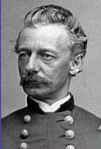 1827
Henry
Warner Slocum, future Union General. 1827
Henry
Warner Slocum, future Union General.
Slocum is born in Delphi, New
York. In 1852, Slocum graduated from the US Military Academy,
seventh in his class of 42. He remained in the military for
just four years, serving in Florida and South Carolina. In 1856,
he left the service to study law, and by 1858 he had established
a practice in Syracuse. After serving in the New York State
assembly, Slocum became a lieutenant colonel in the New York
State militia.
When the US Civil War broke out,
Slocum received command of the 27th New York Infantry and was
commissioned colonel. Slocum fought at the First Battle of Bull
Run in July 1861. Although he was wounded and his regiment suffered
130 casualties out of about 800 present, his star rose rapidly
in the Army of the Potomac. He was promoted to brigadier general
after Bull Run, and by the time the army embarked on the Peninsular
campaign in May 1862, he was a major general. In October 1862,
Slocum received command of the army's XII corps.
During the Chancellorsville campaign
of May 1862, Slocum had developed an intense dislike for General
Joseph Hooker, who was commander of the Army of the Potomac
at the time. After the Yankees were dealt a humiliating defeat
at the hands of an outnumbered Confederate army, Slocum participated
in a movement to have Hooker removed. Although he played a key
role at the Battle of Gettysburg in July, Slocum's corps was
placed under Hooker's command in September in order to reinforce
Union troops in Chattanooga, Tennessee, after the Battle of
Chickamauga. Rather than serve under Hooker, Slocum resigned.
However, his resignation was not accepted, and he was sent to
command forces at Vicksburg, Mississippi.
After Hooker left the army, Slocum
returned to command his old corps, which was now part of General
William T. Sherman's army. Selected to command one wing of the
Federal army during Sherman's famous "March to the Sea," Slocum
remained with Sherman as the Yankees pacified the Carolinas,
and was present at the surrender of General Joseph Johnston's
army at the end of the war.
Slocum resigned his commission
in 1865 and returned to New York. He practiced law in New York
City and served in the US House of Representatives from 1868
to 1873 and again from 1883 to 1885. He died in Brooklyn, New
York, on 14 April 1894. |
1817 Ramón de Campoamor, poeta español.
1807 Friedrich Wilhelm Heinrich Theodor Hosemann, German artist
who did on 15 October 1875.
1801 Ostrogradski,
mathematician
1789 The
first US Supreme Court
^top^
The Judiciary Act of 1789 is
passed, establishing the Supreme Court of the United States
as a tribunal made up of six justices who would to serve on
the court until death or retirement. According to the Constitution,
the size of the court is set by Congress, and the number of
justices varied during the 19th century before stabilizing in
1869 at nine.
The same day, President George
Washington appoints John Jay to preside as chief justice, and
John Rutledge of South Carolina, William Cushing of Massachusetts,
John Blair of Virginia, Robert Harrison of Maryland, and James
Wilson of Pennsylvania as associate justices. Two days later,
all six appointments would be confirmed by the US Senate.
The US Supreme Court was established
by Article Three of the US Constitution, which took effect on
04 March 1789. The Constitution granted the Supreme Court ultimate
jurisdiction over all laws, especially those in which their
constitutionality was at issue. The high court was also designated
to oversee cases concerning treaties of the United States, foreign
diplomats, admiralty practice, and maritime jurisdiction. On
01 February 1790, in New York City's Royal Exchange Building,
the first session of the US Supreme Court was held. The US Supreme
Court later grew into the most important judicial body in the
world in terms of its central place in the American political
order, and in times of constitutional crisis, for better or
worse, always played a definitive role in resolving the great
issues of the time. |
1762 William Lisle Bowles, poet. BOWLES ONLINE: Fourteen
Sonnets, Elegiac and Descriptive
1756 Bénigne Gagnereaux, French artist who died on 18 August 1795
[on the guillotine?]
1755 Robert Jacques François Faust Lefèvre, French painter
who died on 03 October 1830. — LINKS
— Woman
with a Lyre — Jean-Baptiste-Claude
Odiot
1755 John Marshall Va, attorney, 4th Supreme Court Chief Justice
(1801-35) and US secretary of state.
| 1739 (13 September
Julian) Grigory Aleksandrovich Potemkin, Prince (Knyaz) Tavrichesky,
Imperial Prince (Reichsfürst) Russian army officer
and statesman, for two years Empress Catherine II's lover and
for 17 years the most powerful man in the empire. An able administrator,
licentious, extravagant, loyal, generous, and magnanimous, he
was the subject of many anecdotes. Catherine's 1787 tour of
southern Ukraine was a triumph for Potemkin, its governor general,
for he disguised all the weak points of his administration —
hence the apocryphal tale of his erecting stage-set villages
to be seen by the empress in passing. (Potemkin village
came to denote any pretentious façade designed to cover
up a shabby or undesirable condition.) He died on 16 October
1791. |
1724 La nouvelle Bourse de Paris s'installe à l'Hôtel de Nevers, rue
Vivienne. Les agents de change en reçoivent le monopole. Quatre ans plus
tôt, la chute de la banque royale, créée par Law, faisait chanter à tout
Paris ce doux refrain : "Lundi je pris des actions, mardi je gagnai des
millions, mercredi je pris équipage, jeudi j'agrandis mon ménage, vendredi
je m'en fus au bal, et samedi à l'hôpital." On espère secrètement que
cette bourse conjurera la déroute financière du royaume.
1717 Horace Walpole, 4th earl of Oxford, England, writer, creator
of the Gothic novel genre. WALPOLE ONLINE: The
Castle of Otranto
1625 John
de Witt, mathematician + — A Dordrecht, naissance de Jean de
Witt . Homme de loi à La Haye, puis plus tard "Grand Pensionnaire" de
Hollande, il sera souverain virtuel des Provinces Unies. Promoteur de
solides alliance entre l'Angleterre et la Hollande, il combat la France.
Son opposition à l'accession de Guillaume III au trône provoquera des
émeutes au cours dequelles il sera tué, en 1672.
1623 Joris van Son, Dutch artist who died on 25 June 1667.
1501 Girolamo
Cardano, Italy, mathematician/astrologer (Ars Magna-1545), author
of Games of Chance, the first systematic computation of probabilities.
|
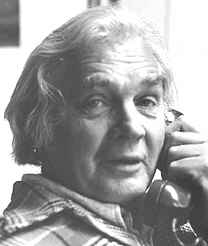 2002
Parliamentary elections in one sector of Indian-occupied Kashmir (Jammu-Kashmir
state). Heading the call from moderate independentists for voting abstention
and a general strike, and fearful of violence from the extremists, almost
no one votes in Srinagar (11% of voters) and the other Moslem-majority
areas. The dates of the elections in the other three sectors are 16 September,
01 October, 08 October.
2002
Parliamentary elections in one sector of Indian-occupied Kashmir (Jammu-Kashmir
state). Heading the call from moderate independentists for voting abstention
and a general strike, and fearful of violence from the extremists, almost
no one votes in Srinagar (11% of voters) and the other Moslem-majority
areas. The dates of the elections in the other three sectors are 16 September,
01 October, 08 October.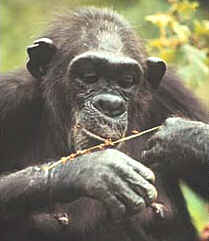 2002
< Not such a close cousin after all. Roy
Britten, 83, a biologist at the California Institute of Technology
[it is NOT his photo at the left, but at the right >], publishes
in the Proceedings of the National Academy of Sciences a study
according to which there is a 5% difference between human and chimpanzee
genes, rather than the 1.5% believed until now. Britten based this on
a computer program that compared 780'000 of the 3 billion base pairs
in the human DNA with those of the chimp. The study does not resolve
the question of which species is superior, or even whether such a question
is meaningful.
2002
< Not such a close cousin after all. Roy
Britten, 83, a biologist at the California Institute of Technology
[it is NOT his photo at the left, but at the right >], publishes
in the Proceedings of the National Academy of Sciences a study
according to which there is a 5% difference between human and chimpanzee
genes, rather than the 1.5% believed until now. Britten based this on
a computer program that compared 780'000 of the 3 billion base pairs
in the human DNA with those of the chimp. The study does not resolve
the question of which species is superior, or even whether such a question
is meaningful.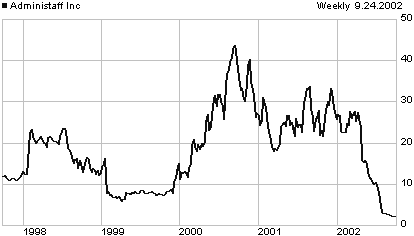 Final third quarter results will primarily depend on the following key
metrics for the month of September: (1) the number of worksite employees
paid; (2) the average payroll cost per worksite employee; (3) gross markup
per worksite employee; (4) direct costs, including payroll taxes, benefits
cost and workers' compensation insurance costs; and (5) operating expenses.
Final third quarter results will primarily depend on the following key
metrics for the month of September: (1) the number of worksite employees
paid; (2) the average payroll cost per worksite employee; (3) gross markup
per worksite employee; (4) direct costs, including payroll taxes, benefits
cost and workers' compensation insurance costs; and (5) operating expenses.
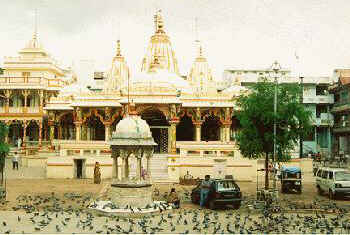 Deaths
Deaths 17:30:
Security forces arrive on the scene.
17:30:
Security forces arrive on the scene.
 1991
1991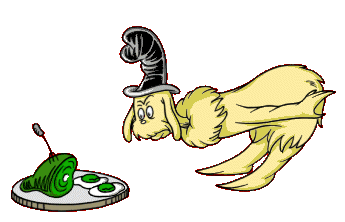 Say?,
Oh, the Thinks You Can Think!, One Fish Two Fish Red Fish Blue
Fish, Ten Apples Up on Top!, And to Think That I Saw It on Mulberry
Street, Bartholomew and the Oobleck, The Butter Battle Book,
Did I Ever Tell You How Lucky You Are?, Dr. Seuss's Sleep Book,
The 500 Hats of Bartholomew Cubbins, Happy Birthday to
Say?,
Oh, the Thinks You Can Think!, One Fish Two Fish Red Fish Blue
Fish, Ten Apples Up on Top!, And to Think That I Saw It on Mulberry
Street, Bartholomew and the Oobleck, The Butter Battle Book,
Did I Ever Tell You How Lucky You Are?, Dr. Seuss's Sleep Book,
The 500 Hats of Bartholomew Cubbins, Happy Birthday to  You,
Hooray for Diffendoofer Day!, Horton Hatches the Egg, Horton
Hears a Who!, How the Grinch Stole Christmas!, Hunches in Bunches,
I Can Lick 30 Tigers Today! and Other Stories, I Had Trouble
in Getting to Solla Sollew, If I Ran the Circus, If I Ran the
Zoo, The King's Stilts, The Lorax, McElligot's Pool, My Book
About Me, My Many Colored Days, Oh, the Places You'll Go!, On
Beyond Zebra!, Scrambled Eggs Super!, The Sneetches and Other
Stories, Thidwick the BigHearted Moose, Yertle the Turtle and
Other Stories, You're Only Old Once!, Great Day for Up I, Myself
Marvin K. Mooney Will You Please Go Now!, Mr. Brown Can Moo!
Can You?, The Shape of Me and Other Stuff, There's a Wocket
in My Pocket, Did I Ever Tell You How High You Can Count?: Learn
About Counting Beyond 100.
You,
Hooray for Diffendoofer Day!, Horton Hatches the Egg, Horton
Hears a Who!, How the Grinch Stole Christmas!, Hunches in Bunches,
I Can Lick 30 Tigers Today! and Other Stories, I Had Trouble
in Getting to Solla Sollew, If I Ran the Circus, If I Ran the
Zoo, The King's Stilts, The Lorax, McElligot's Pool, My Book
About Me, My Many Colored Days, Oh, the Places You'll Go!, On
Beyond Zebra!, Scrambled Eggs Super!, The Sneetches and Other
Stories, Thidwick the BigHearted Moose, Yertle the Turtle and
Other Stories, You're Only Old Once!, Great Day for Up I, Myself
Marvin K. Mooney Will You Please Go Now!, Mr. Brown Can Moo!
Can You?, The Shape of Me and Other Stuff, There's a Wocket
in My Pocket, Did I Ever Tell You How High You Can Count?: Learn
About Counting Beyond 100.